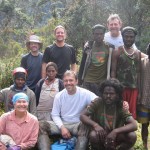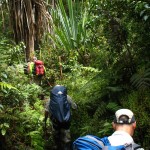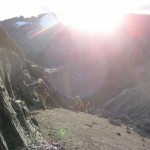August 22, 2012
Carstensz Pyramid is truly a unique and desirable adventure. It is what I imagine the previous generation of climbing expeditions were like. Things usually have the potential to go sideways, and you never know what type of obstacle you will face the next day.
Our adventure began not at the trail head, but in the tiny Timika airport where we learned the meaning of Papuan Time: “things won’t happen until they happen and you can do very little about itâ€. We were delayed by a day because a plane on the dirt landing strip in Sugapa had a tire problem and was blocking the runway. In order to fix the plane a spare tire was flown to the nearest village and carried on some poor soul’s back to the Sugapa runway. When our mud boots finally touched down in Sugapa, Jamie, one of our local guides, welcomed us “to the other side of nowhereâ€. We were informed that there was going to be an election rally the next day in Sugapa and that we should keep a low profile and get on the trail as soon as possible.
We trekked into the jungle through freshly cleared corridors that really couldn’t be called trails. Although it was raining, the day was still hot, and it was dark when we finally reached Camp 1: a surprisingly welcome sight of a small wooden hut that we all piled into, relieved not to have to set up tents in the dark.
- Some of the team. (Dan Zokaites)
- Long ways down (Dan Zokaites)
- Heading into the jungle. (Jason Edwards)
- Climbing. (Dan Zokaites)
In the morning we gained more porters through an elaborate process that continued through just about every village we passed. The local Papuan porters all traveled through this rugged terrain in their bare-feet, the ultimate Carstensz footwear. Their bare feet dried instantly when the trail was dry and had dexterity unknown to us westerners that allowed them to grip slippery logs and rocks with their toes. Every night the porters would build a stick A-frame over which they stretched large tarps and secured them with tree roots they found on site. The Papuans did not bring bedding so they slept huddled together inside their tarp huts with two fires burning all night.
On Day three it took us 9 hours to go 7 miles due to the challenging terrain. As dusk fell we walked out of the jungle into the high grasslands of the plateau. We were relieved to finally be out of the jungle and excited to see smoke from the fires burning in camp. Just before camp we reached a stream and it was all I could do to convince everyone to cross it before ditching packs and tearing off muddy boots and splashing off our mud caked bodies.
Day four we learned that in Papua “plateau†was actually another word for marsh. The soggy land had the ability to keep steep hillsides wet and pull the rubber mud boots we wore off our feet any time it wanted.
On day six, the final challenge of the trek was getting over New Zealand pass, which involved some vertical mud climbing, rock scrambling and steep hiking. This brought us to Base Camp at 13,800 feet. Because it had been raining all day, we had our summit talk with the assumption that we were going to climb to the top of the mountain in sheets of rain.
I woke up at 1:50AM, 10 minutes before my alarm went off, and the whole tent was lit up by the moon, and in my sleepy state it took me a few minutes to realize what it was or its significance: the night was clear i.e no rain! In this moonlight world we started upwards to the summit of Carstensz Pyramid amazed at our good fortune to have a dry morning. The terrain narrowed into a rocky gully and we started up the fixed lines. As we were still only in moonlight, the pre-trip training really paid off. When we gained the ridge the sun slipped above the horizon, lighting glaciers, and as each member of the team saw the view we were equally stunned. Carol, the oldest women to complete the Seven Summits, who calls herself the Silver Fox, let out one of her name sake howls and many of us joined her. At this point there was an unspoken expectation that we where going to make it to the summit and all our toil in the mud and jungle was to be well worth the reward.
When we reached the tyrolean traverse I was impressed by how well our team handled the 2,000 feet of exposure. This is an experience you are definitely not going to have on any other of the Seven Summits. After negotiating some more technical terrain higher up the ridge, the entire team reached the summit in perfect sunshine with fantastic views of the Arafura Sea, the largest gold mine in the world, and glaciated peaks. Our way down was blessed with continued good weather, and then minutes after taking a post climb photo, the skies unleashed the heaviest rain we had experienced yet, as if to let us know how lucky we were to have had a sunny summit.
The next day we where back to the normal rain, rain, and more rain. The way out seemed significantly easier as our jungle skills and balance had noticeably improved and we strode confidently across slippery logs with raging rivers below that we had tentatively scooted across on the way in.
As we reached the outskirts of Sugapa, and the end of our trek, we feasted on passion fruit, the best sweet potatoes I have ever eaten, elephant fruit, and sugar cane. As the group joked and tossed fruit to one another and my stomach was filled with simple tasty treats, I felt the simple rewards of life in a natural state. Summiting Carstensz is a combination of many unexpected experiences, and is a rare adventure that can only be found in a few isolated corners of the world.
Daniel Zokaites




